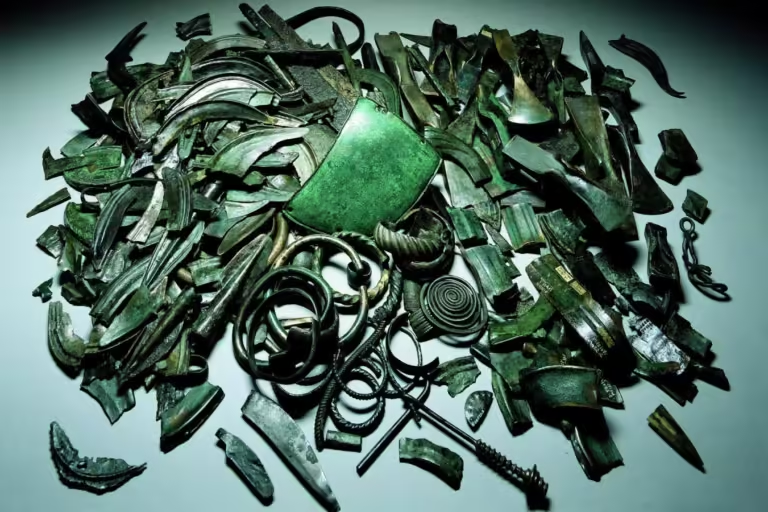
Bronze Age metal hoard from Weisig, Germany
J. Lipták/Landesamt für Archäologie Sachsen
Bronze Age Europeans earned and spent money in much the same way we do today, indicating that the origins of the “market economy” are much older than expected.
This is the controversial conclusion of a new study that challenges the view that elites were the dominant force in the Bronze Age economy and suggests that human economic behaviour may not have changed much over the past 3,500 years or more.
“We tend to romanticize European prehistory, but the Bronze Age was not just a fantasy world where townspeople and peasants served their needs as a backdrop for great lords,” says Nicola Ialongo of Aarhus University in Denmark. “It was a very familiar world, where people had families, friends, social networks, markets, jobs, and ultimately had to figure out how to make ends meet.”
Bronze Age Europeans, who lived between 3300 and 800 BCE, weren’t meticulous bookkeepers like people in other ancient societies, such as those in Mesopotamia, but Ialongo and Giancarlo Lago of the University of Bologna in Italy suggest that the treasure troves they left behind may hold important insights into their daily lives and the roots of modern economic behavior.
Lago and Ialongo analyzed more than 20,000 metal objects from Bronze Age burial sites in Italy, Switzerland, Austria, Slovenia and Germany. Although the objects come in a variety of shapes, starting around 1500 BCE, they began to become standardized in weight, a change that many experts believe marks them out as a pre-coinage form of money.
“The discovery of widespread systems of measurement and weight allows us to model things that have been known for centuries in ways that have never been modeled before,” Ialongo says. “This not only gives us new answers to old questions, but it also gives us new questions that no one has asked before.”
The team found that the weight values in their vast sample followed the same statistical distribution as the daily expenses of a modern Western household: small everyday expenses, represented by lighter pieces, dominated the consumption pattern, while larger expenses, represented by heavier pieces, were relatively rare. This pattern is similar to that found in the average modern wallet, with many small bills and very few large bills.
Lago and Ialongo interpret their find as evidence that the Bronze Age economic system was regulated by market forces of supply and demand, with everyone participating in proportion to how much they earned. This hypothesis contrasts with the influential view put forward by anthropologist Karl Polanyi in the 1940s, who characterized the modern economy, based on monetary gain, as a new phenomenon distinct from ancient economies centered on barter, gift exchange, and social status.
Richard Blanton of Purdue University in Indiana thinks the study is credible: “I think this argument will stimulate debate among archaeologists and economic anthropologists who have lived for decades under false assumptions about the antiquity of market economies,” he says.
“I think this paper adds useful fuel to that criticism,” Brunton says, “and to me it sheds entirely new light on the function of bronze deposits and the potential use of bronze coins as a unit of exchange.”
But Erica Schonberger of Johns Hopkins University in Maryland is skeptical of the team’s conclusions. “It’s dangerous to assume that ordinary people in premodern times used money for general economic activity,” Schonberger says. “For example, medieval English peasants only got money for selling their produce when their lords began to demand money in lieu of rent in kind or taxes. The peasants gave most or all of that money directly to their lords. They sold their produce to get money, but they didn’t use it to buy things they needed. We’re still a long way from modern economic activity (in the Middle Ages).”
Lago and Ialongo hope that their work will inspire other experts to carry out similar studies on artefacts from different regions and cultures. They suggest that market economies are a natural development across time and cultures, and that such systems are not something new or unique that has emerged in Western societies over the past few centuries.
“Technically, we haven’t proven that the Bronze Age economy was a market economy,” Ialongo says, “we simply have no evidence that it wasn’t. And we’re just pointing out a contradiction: why is everyone so convinced that there wasn’t a market economy when everything we see can be explained by a market economy model? In other words, if the simplest explanation works well enough, why should we have to imagine a more complex one?”
topic:

